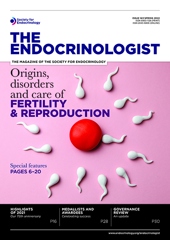A year ago (in The Endocrinologist issue 139), John Wass wrote an article introducing the concept of the Endocrine Specialist Networks (ESNs). He commented, “The purpose of these networks would be to ensure the provision of experience in some of these rarer forms of endocrinology, within each locality.” Twelve months and at least one major COVID wave later, we thought it was a good time to provide colleagues with an update on progress in setting up the networks.
BONE AND CALCIUM ESN
'An interesting, emerging theme is that all three ESNs are evolving with a degree of cross-disciplinarity...This seems like a positive development and one that bodes well for the future.'
In the bone and calcium ESN, we have advertised for membership, reviewed applications (which were rigorously scored against pre-agreed criteria) and announced the results of this initial application process. We are pleased to report that there were 11 applications in spring/summer 2021, of which nine were successful. Two meetings of the nine centres have been held so far and an initial work plan agreed.
Probably one of the most important goals at this stage is to raise awareness of these nine centres amongst colleagues in other hospitals, so that there will be a low and comfortable threshold for picking up the phone or emailing for advice. Hopefully, communication will be further improved as regional multidisciplinary teams are established, audits and research projects get underway, and other initiatives, such as training meetings, begin.
ANDROLOGY ESN
The andrology ESN was created to gather endocrinologists, urologists and reproductive medicine gynaecologists with an interest in male reproductive health. It brings together expertise from England, Scotland, Wales and Ireland, to provide referral hubs for ‘tricky problems’.
For instance, gonadotrophins, such as human chorionic gonadotrophin, can restore sperm in the ejaculate of men with hypogonadotrophic hypogonadism. However, their prohibitive costs put them out of the reach of most hospitals. The andrology ESN is applying to NHS England to fund this important therapy centrally, so that men could receive treatment within its hubs. This will take time, but a national co-operative has a greater chance of winning than a lone, ivory tower.
Emerging therapies such as microdissection testicular sperm extraction (micro-TESE) offer the possibility of fatherhood for a minority of men with Klinefelter syndrome. However, few UK centres offer micro-TESE, and the potential reward of fatherhood needs to be weighed against the potential devastation of unsuccessful treatment. The andrology ESN will give all endocrinologists (and their patients) access to current advice and state-of-the-art treatments, regardless of their postcode.
GENDER HEALTHCARE ESN
The gender healthcare ESN has held its inaugural meeting. The aim of the group is to improve the sharing of knowledge and create a network of endocrinologists with an interest in gender medicine, to help support our colleagues in the field.
Given that gender medicine is an important endocrine topic, we have approached the Specialty Advisory Committee of the Royal College of Physicians to ensure that this area can be included in the core endocrine curriculum soon. We have also recognised that there is a significant expansion of gender healthcare medicine, with new gender clinics being set up throughout the UK which will need endocrine support. The gender healthcare ESN is also keen to improve the research base that underpins medicine in this area.
LOOKING FORWARD
An interesting, emerging theme is that all three ESNs are evolving with a degree of cross-disciplinarity. For example, the bone and calcium ESN has some rheumatology membership, while similarly in the andrology and gender healthcare ESNs there is involvement from urologists and other specialists. This seems like a positive development and one that bodes well for the future.
While there is clearly a long way to go in terms of getting the ESNs fully up to speed, maximising awareness of them and achieving delivery of improved care for patients with complex endocrine conditions, hopefully this is a reasonable start, and things will go from strength to strength.
Jeremy Turner
Neil Gittoes
Channa Jayasena
Leighton Seal
John Wass





